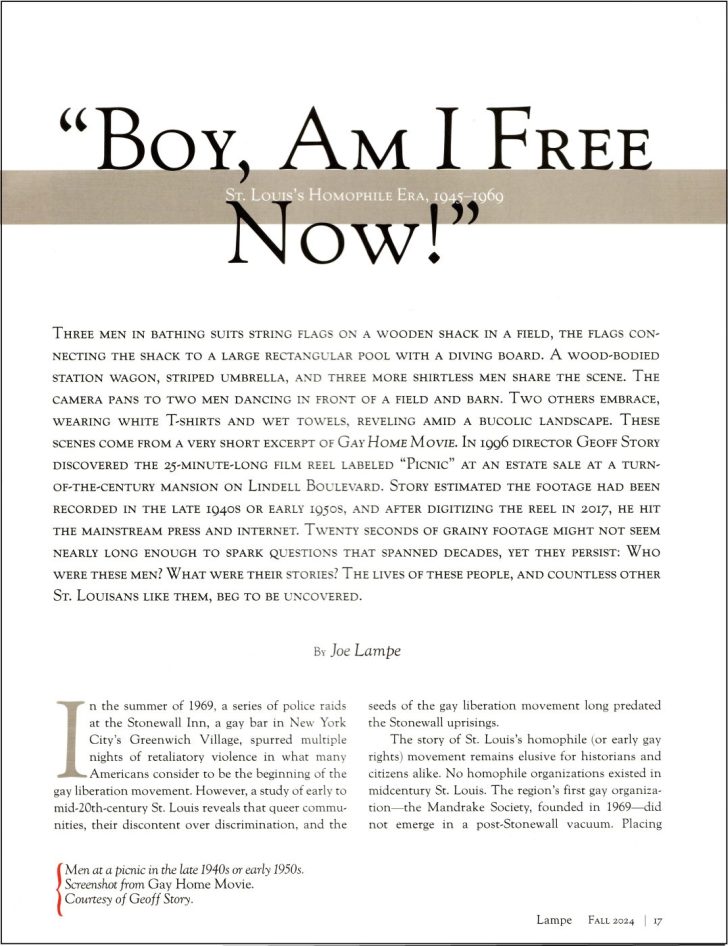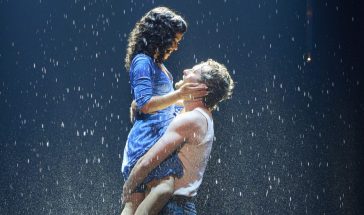By Rodney Wilson

Courtesy of Rodney Wilson
I live in the past as much as I live in the present, and often I’m more comfortable in an imaginary conversation with the dead than when engaging with the living. In visiting the physical spaces that once sheltered people, dreams, movements, and institutions, I exchange the imagined, or the only read about, for a reality that I can see and touch, taste and smell. Lincoln spoke of the “mystic chords of memory,” and it is when I stand in historic sites that I hear those mystical chords close by.
I had an inspiring time, therefore, this past week while in St. Louis to attend the James Neal Primm Lecture in History at the Missouri History Museum. The talk by LGBTQ history pioneer John D’Emilio was informative and uplifting, and the trip north from my rural Farmington home provided an opportunity to revisit sites that hold LGBTQ community memories, allowing a moment of travel through time.
With a few hours to spare before the evening lecture, I first hopscotched across the city to visit three physical structures that between 1973 and 1996 housed the St. Louis congregation of the Universal Fellowship of Metropolitan Community Churches (UFMCC), an international Christian denomination founded in Los Angeles in 1968.
The St. Louis congregation was pioneered in October 1973 by a 27-year-old woman born in rural Poplar Bluff, Missouri, in 1946. Her name is Carol Cureton. I got to know Carol more than thirty years ago when I had the honor of writing about her and MCC-St. Louis for a graduate paper at UMSL, an assignment that would evolve into the first LGBTQ history ever published by the Missouri Historical Society (MHS), in their Fall 1994 issue of Gateway Heritage.

Three of MCC’s buildings. Courtesy of Rodney Wilson.
MCC-St. Louis first used a shared space with the Berea Presbyterian Church, built in 1929 on Olive in the former Mill Creek Valley neighborhood. The building now abuts the Harris-Stowe State University campus, but belongs to Saint Louis University and was renamed Il Monastero by SLU in the early 2000s. MCC met at Berea from its founding in the fall of 1973 until the early winter of 1974, when some Berea members grew uncomfortable with an avowed “gay church” using their worship space, especially after a March 1974 Post-Dispatch article headlined “Homosexuals Gather for Church Meeting” used the Presbyterian church’s name and raised public awareness about the nature of the new St. Louis congregation.
By year’s end in 1974, the church purchased a property of its own, at 5108 Waterman Blvd. “Homosexuals Plan Church Dedication,” shouted a 1975 St. Louis Post-Dispatch headline the next spring. From the outside, the 1905 Victorian-era home appeared like the others on the street. On the inside, however, it held the remains of the Theosophical Society of St. Louis, including the circa 300-seat capacity auditorium built by the Society after they purchased the home in 1928 and made it their St. Louis headquarters. It was an ideal space and location for a growing church and MCC remained on Waterman for a decade, creating a de-facto LGBTQ community center that provided meeting places for many nascent LGBTQ community organizations in St. Louis.

Courtesy of Rodney Wilson
A decade later, in 1984, MCC moved to their third location, at 1120 Dolman in the Lafayette Square neighborhood. The Post-Dispatch in August 1984 told the story in an article headlined “Homosexual Congregation Gets Church.” Originally, an Episcopal church constructed in the 1870s and later a Ukrainian Orthodox church, MCC stayed in the Dolman building for over a decade before selling it in 1996. I recall the building in a bit of disrepair in the 1990s when I occasionally attended services there, so was happy to see it still standing today – and still an active congregation, St. Mary’s Assumption, that seems to have put sufficient funds toward shoring up the structure.
After a full afternoon spent with spaces once inhabited by the LGBTQ Christian community of St. Louis, I made my way to the historic Gerhart Block at Vandeventer and Laclede. Built in 1896, the block of beautiful buildings, now on the National Register of Historic Places, ironically sits across Forest Park Avenue from a definitely-not-historic and definitely-not-beautiful big blue box called Ikea. In this row of buildings, at 11. S. Vandeventer, was Bill Cordes’ Our  World Too bookstore, which occupied the space for over a decade, from the late 1980s to the late 1990s, a place where pre-Internet LGBTQ St. Louisans could find valuable resources. Unoccupied now, I peeked through the dirty window, where I saw Bill behind the counter next to the door that led down to the musty basement where stock was stored and where our Lambda Historical Society met in the mid-1990s to discuss LGBTQ history. For a moment, staring into that physical space, the clock stopped in 1995.
World Too bookstore, which occupied the space for over a decade, from the late 1980s to the late 1990s, a place where pre-Internet LGBTQ St. Louisans could find valuable resources. Unoccupied now, I peeked through the dirty window, where I saw Bill behind the counter next to the door that led down to the musty basement where stock was stored and where our Lambda Historical Society met in the mid-1990s to discuss LGBTQ history. For a moment, staring into that physical space, the clock stopped in 1995.
I had a meet up scheduled with Joe Lampe, whose essay “Boy, Am I Free Now!” about post-WWII LGBTQ St. Louis was published in the MHS’s Fall 2024 Gateway, another milestone piece on LGBTQ St. Louis-area history, and only the second full-length queer history essay to be published in Gateway, precisely thirty years after my article about Carol Cureton – so a perfect bookend. (The Fall 2024 issue of Gateway is available for purchase at the Missouri History Museum’s magnificent Sold on St. Louis gift shop.) Enjoying the past as we do, he and I opted to meet at the Saucy Porka restaurant, which occupies the space that Magnolia’s Bar and Restaurant once did, 5 S. Vandeventer, just a few doors down from Our World Too. Meeting in a historic structure to discuss history seemed the only place appropriate for the occasion.
After dinner, we headed to the Missouri History Museum, to walk through the Gateway to Pride exhibit (again!), and to hear John D’Emilio’s lecture. The pre-lecture Happy Hour allowed an opportunity to speak briefly with several long-time friends who have been doing human rights work for decades: Philip Deitch, Kris Kleindienst, Joan Lipkin, Steven Louis Brawley, Michael Slawin, Jim Kemp, Alan Easton; and also to get a quick photo with two activists who have been engaged in moving the world forward since the 1970s: Margaret Flowing Johnson, a trailblazer in women’s and lesbian rights work; and Jym Andris, a pioneer in the preservation of LGBTQ stories, lives, and documents.

Rodney Wilson with the pioneering LGBTQ historian John D’Emilio. Courtesy of Rodney Wilson
It was a day of highlights and warm memories and meeting John D’Emilio at the end of the evening, for the first time in person, was a special moment. I was introduced to his work in the fall of 1993 while taking a graduate course in history at UMSL called Social Movements of the 1960s. His 1983 book, published by the University of Chicago Press and named Sexual Politics, Sexual Communities: The Making of a Homosexual Minority in the United States, 1940–1970 was transformative in my life. It made me aware that LGBTQ people do have a history. It set me toward writing the paper about Carl Cureton. It also nudged me to write the January 1994 proposal to name that October the first ever LGBTQ+ History Month. And it helped embolden me to “come out” on the job at my South County high school in March 1994. Meeting a historic historian at night’s end, after a day of visiting historical queer St. Louis sites, was a most perfect conclusion to a most perfect day. My heart was full.
Rodney Wilson has been an educator since 1990; he founded LGBTQ+ History Month in 1994 and co-founded the International Committee on LGBTQ+ History Months (ICoHM) in 2021. He is the subject of the documentary short Taboo Teaching, available here.



